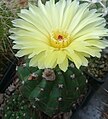Parodia ottonis
| Parodia ottonis | |
|---|---|

| |
| Scientific classification | |
| Kingdom: | Plantae |
| Clade: | Tracheophytes |
| Clade: | Angiosperms |
| Clade: | Eudicots |
| Order: | Caryophyllales |
| Family: | Cactaceae |
| Subfamily: | Cactoideae |
| Genus: | Parodia |
| Species: | P. ottonis
|
| Binomial name | |
| Parodia ottonis (Lehm.) N.P.Taylor
| |
Parodia ottonis, also known as Indian head cactus, is a cactus found in Argentina, Brazil, Paraguay and Uruguay. There are two recognized subspecies.[1] The epithet ottonis honors the German botanist Christoph Friedrich Otto.
Description
[edit]The plant at first grows individually and later forms groups. The light to dark green or blue-green spherical shoots are often tapered towards the base. They reach diameters of 3 to 15 centimeters. The six to 16 distinct ribs are rounded or sharp-edged. There are usually only a few areoles on each rib . The bristle-like thorns that spring from them are straight, curved or twisted. The one to four central spines are brownish, reddish brown or yellowish and have a length of 0.8 to 4 centimeters. The four to 15 spines are whitish to yellowish or brownish and 0.5 to 3 centimeters long.[2]
The usually yellow flowers, rarely orange-red or red, reach lengths of 5 to 6 centimeters and would appear in late summer. Its flower tube is covered with brownish wool and bristles. The scars are dark red. The thick-walled egg-shaped to short cylindrical fruits tear open. They have diameters from 0.9 to 1.3 centimeters. The fruits contain, often very numerous, bell-shaped, glossy black seeds, which are strongly humped.[3]
Range
[edit]Parodia ottonis is common in southern Brazil, southern Paraguay, Uruguay, and northeastern Argentina.[4]
Taxonomy
[edit]The first description as Cactus ottonis by Johann Georg Christian Lehmann was published in 1827. Nigel Paul Taylor presented the type 1987 in the genus Parodia . Other nomenclatural synonyms are Echinocactus ottonis (Lehm.) Link & Otto (1830), Malacocarpus ottonis (Lehm.) Britton & Rose (1922), Notocactus ottonis (Lehm.) A.Berger ( 1929) and Peronocactus ottonis (Lehm.)[5]
The following subspecies are distinguished:
- Parodia ottonis subsp. ottonis
- Parodia ottonis subsp. Horstii (F. Knight)
Gallery
[edit]-
A flowering specimen
-
Botanical illustration
-
Flower closeup
-
Side view of flower
References
[edit]- ^ a b IUCN (2010). "Parodia ottonis: Larocca, J., Machado, M. & Duarte, W." IUCN Red List of Threatened Species. doi:10.2305/iucn.uk.2013-1.rlts.t151932a577721.en.
- ^ Zuloaga, FO, O. Morrone, MJ Belgrano, C. Marticorena & E. Marchesi. (eds.) 2008. Catalog of Vascular Plants of the Southern Cone (Argentina, South of Brazil, Chile, Paraguay and Uruguay). Monogr. Syst Bot. Missouri Bot. Gard 107 (1): i-xcvi, 1-983; 107 (2): i-xx, 985-286; 107 (3): i-xxi, 2287–3348.
- ^ Urs Eggli, Leonard E. Newton: Etymological Dictionary of Succulent Plant Names. Springer, Berlin / Heidelberg 2010, ISBN 978-3-642-05597-3 , p. 174.
- ^ David Hunt, Nigel Taylor: New and unfamiliar names of Cactaceae to be used in the European Garden Flora . In: Bradleya . Volume 5, 1987, p. 93.
- ^ Edward F. Anderson: The Great Cactus Encyclopedia . Eugen Ulmer KG, Stuttgart 2005, ISBN 3-8001-4573-1 , pp. 508-509 .





